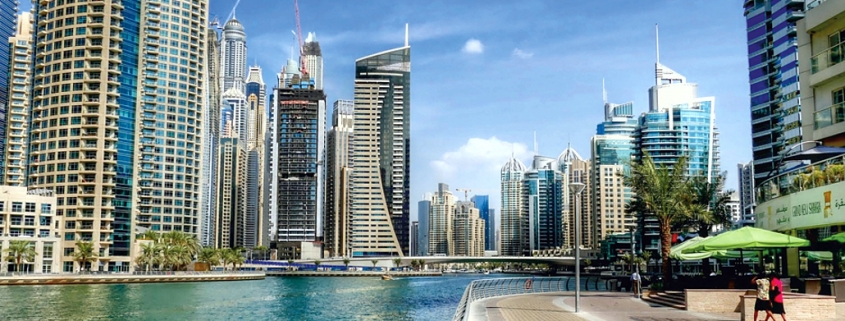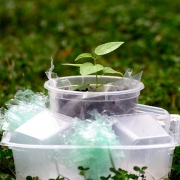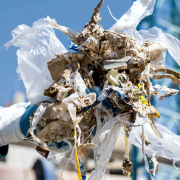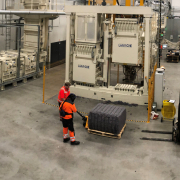United Arab Emirates: On the Road to Zero Waste
The United Arab Emirates (UAE) has begun to intensify its recycling efforts. One important goal is to divert 75 percent of waste from landfills by 2021.
This strategic objective is part of the country’s Vision 2021, a long-term plan, launched in 2010, “that aims to make the UAE one of the best countries in the world by the year 2021 when the UAE would celebrate the Golden Jubilee of its formation as a federation”, the website of the government informs. The United Arab Emirates is a federation of seven emirates – Abu Dhabi, Dubai, Sharjah, Ajman, Um Al Quwain, Ras Al Khaimah and Fujairah – that united in 1971. The rulers of the emirates form the Federal Supreme Council. One of the rulers serves as the President of the United Arab Emirates; federal capital is Abu Dhabi.
In UAE, federal government authorities handle core policy and service delivery portfolios including foreign relations, interior policies and services as well as environmental policy, education and health, to name but a few. Local governments are responsible for the delivery of municipal services such as waste management, local urban planning, land usage, sewerage, sanitation, economic licensing, local roads, public transportation and so forth in accordance with federal policies, strategies and standards. However, each emirate has considerable autonomy to shape their development trajectories using UAE’s national vision – Vision 2021 – as a template for forward planning.
In 2014, H.H. Sheikh Mohammed bin Rashid Al Maktoum, Vice President and Prime Minister of the UAE and the Ruler of Dubai, launched the “National Agenda” to guide efforts towards Vision 2021. It specifies a wide-ranging work program centered around six national priorities and 52 National Key Performance Indicators (NKPIs). One priority is a sustainable environment and infrastructure. According to the report “The United Arab Emirates and the 2030 Agenda for Sustainable Development – Excellence in Implementation: Executive Summary”, published in 2018 by the National Committee on Sustainable Development Goals, one of the key priorities for the UAE is to ensure economic and social development with an appreciation for environmental sustainability. “The Vision 2021 National Agenda focuses on improving the quality of air, preserving water resources, increasing the contribution of clean energy and implementing green growth plans,” the authors stated. “The Agenda also highlights the importance of infrastructure and aims for the UAE to be among the best in the world in the quality of airports, ports, road infrastructure, electricity and telecommunications infrastructure.”
Furthermore, in January 2017 the UAE government formed a National Committee on Sustainable Development Goals (SDGs), which is responsible for the national implementation of the goals, monitoring and reporting of progress towards targets and stakeholder engagement. The process to develop the SDGs was launched by the UN Conference on Sustainable Development (Rio+20) in June 2012. The UAE was part of the negotiations and represented the Arab Group. In September 2015, the UN member states adopted the 2030 Agenda for Sustainable Development. The SDGs include a set of targets and indicators that aim to help, guide and measure sustainability for both the private and public sector.
The waste situation
As reported by the publication “Arabian Business” in 2017, the United Arab Emirates is considered to be one of the largest producers of waste in the Gulf region. The estimated population of more than 9.2 million are said to have generated about 29 million tons of waste in that year. Only 20 percent of this amount was recycled, according to official estimates. The volunteer-driven initiative EcoMENA quantifies the per capita rate of municipal solid waste (MSW) from 1.76 to 2.3 kilograms/day. “According to a recent study, the amount of solid waste in UAE totaled 4.892 million tons, with a daily average of 6,935 tons in the city of Abu Dhabi, 4,118 tons in Al Ain and 2,349 tons in the western region,” Salman Zafar wrote in June last year. And the World Future Energy Summit, which took place in January this year in Abu Dhabi, informed on its homepage, that the UAE currently has a waste generation ratio of between 1.9 to 2.5 kilograms per person per day, with around 77 percent of the waste ending up in landfill sites.
In Abu Dhabi, the largest emirate in the country occupying 84 percent of the national landmass territory, the estimated population of 2.65 million (around mid-2014 according to government data) generated 9.657 million tons of solid waste in 2017 (2016: 9.675 million tons). As reported by the Statistics Center Abu Dhabi, non-hazardous waste formed 98.1 percent, while hazardous waste accounted for 180,410 tons or 1.9 percent. In 2017, the amount of non-hazardous solid waste in the Emirate of Abu Dhabi was 9.477 million tons, down from nearly 9.599 million tons in 2016. Of the total quantity 3.959 million tons was construction and demolition waste, 3.169 million tons industrial and commercial waste, 933,505 tons agriculture waste and 1.372 million tons municipal waste; included in the total amount are also other wastes on the scope of 42,861 tons. According to the information, the daily per capita municipal waste was roughly 1.29 kilogram/day. The recycling rate in the Emirate of Abu Dhabi was 28.4 percent in 2017. In that year, nearly 2.688 million tons of waste were recycled, while 7,514 tons went for incineration and 209,188 tons were composted; 561,940 tons were landfilled, and 6.010 million tons were disposed of at dumpsites and through other specialized companies. “The total number of waste management projects in the Emirate of Abu Dhabi reached 32 projects in 2017,” the Statistics Center informed.
Dubai is the second largest emirate of the UAE. Its population size was estimated to be more than 2.446 million individuals at the end of 2015. In the first quarter of the year 2017, a total amount of 6.4 million metric tons of non-hazardous waste (domestic, horticulture, construction and demolition as well as sludge) was treated. Of the domestic waste, 681,629 tons ended up in landfills, while 153,251 tons went for recycling. In that year the recycling volume of domestic waste totaled 877,544 tons. For non-hazardous waste, the Emirate of Dubai has one treatment facility and four landfill sites – and no incineration plant.
Sharjah is the third largest emirate in the UAE. According to the statistics of the UAE Federal Competitiveness and Statistics Authority (www.fcsa.gov.org), the waste generated by the about 1.2 million people in this emirate totaled 2.845 million tons, which were collected and managed in dumps in 2016. In that year, in the Emirate of Ajman the collected and managed waste volume was 960,809 tons, in the Emirate of Um Al Quwain 201,055 tons, in the Emirate of Ras Al Khaimah 991,671 tons and in the Emirate of Fujairah 479,833 tons; with nearly 19.529 million tons the Emirate of Dubai generated the largest waste volume, followed by the Emirate of Abu Dhabi with 9.682 million tons. All in all, the – collected and dumped – waste volume in the country in 2016 was about 34.690 million tons, the statistical data said. Hazardous waste accounted for 0.7 percent of the total waste quantity.
Waste management in UAE
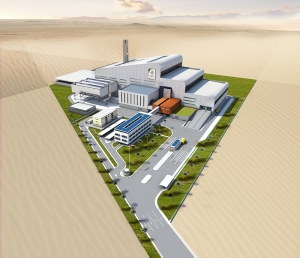
The world’s largest energy-from-waste
plant is to be built in the Emirate of Dubai (Photo: Hitachi Zosen Inova)
As is reported by the official portal of the UAE government, the country now handles its waste issues through recycling and converting waste to energy and resources, new technologies and improved waste separation and collection systems. Here are some examples. The government of Abu Dhabi has established the Center of Waste Management, Tadweer, in 2008. The company is responsible for the policy, strategy and contractual systems of waste management across the emirate. According to WAM, the UAE news agency, Tadweer had collected 1,147,844 tons (daily average of 6,376.90 tons) of waste, in the Emirate of Abu Dhabi during the first half of 2018. The waste was collected through its operational service contracts, which provide local waste collection and transportation services, but does not include industrial and commercial waste that is separately collected by environmental services providers licensed by Tadweer. The waste was transported to the company’s facilities where it was “recycled, treated and disposed of, in compliance with the highest international environmental standards”. One of the commonly-used treatment methods is converting agricultural and organic wastes to organic fertilizers, WAM reported. The Abu Dhabi Center of Waste Management has adopted “a comprehensive waste management strategy that focusses on reducing waste and minimizing waste disposal and treatment costs,” Dr. Salem Al Kaabi, Acting General Manager of Tadweer, was quoted. “Since early 2018, Tadweer has intensified its efforts to address the environmental challenges facing the emirate of Abu Dhabi and mitigate the adverse impact of waste on our environment. As part of this priority, we have implemented several innovative projects, such as Abu Dhabi’s first civic amenity for recyclable materials in Abu Dhabi City, as well as other types of recycling centers.”
Furthermore, the company and Etihad Airways (the national airline of the United Arab Emirates) will collaborate on the waste-to-fuels project, the publication “Bioenergy International” wrote in October last year. The aim is to explore how municipal solid waste (MSW) can be converted into jet fuel to be used on Etihad Airways’ flights. According to the information, the two companies will explore the possibility of developing a long-term project with additional partners and will start with an initial feasibility study to develop a flagship waste-to-fuel facility in Abu Dhabi. “The project is anticipated to show environmental benefits in reducing the overall carbon footprint of the aviation sector while being cost competitive with conventional jet fuel production based on average oil prices,” the publication wrote.
In the Emirate of Dubai, the opening of “The Recycling Hub” was set for early 2019, the UAE-based company EnviroServe announced in November last year. The electronics recycling facility (value: more than 30 million US-Dollar) features zero-to-landfill and zero-to-air process, the information said. It will be the final destination for waste electronics from South Africa in the south to the Caucasus in the north. According to EnviroServe, the plant will be “the world’s largest fully-integrated electronics recycling facility” with a processing capacity of nearly 40 million kilograms of electronic waste annually. “The Recycling Hub” also features a brand protection service, a IT refurbishment center and a refrigerant gas reclamation division. At its core, the facility is using state-of-the-art Swiss technology. “The new facilities will recycle only through granulation processes which means that no chemicals or water is involved in this process,” the website of Switzerland Global Enterprise (www.s-ge.com) described the recycling procedure. “The dust that comes of this process will also be captured and processed. The plant will also be completely solar-powered with photovoltaic panels installed throughout the building.”
Furthermore, the “world’s largest energy-from-waste plant” is to be built in the Emirate of Dubai. Zurich-based Hitachi Zosen Inova (HZI), together with BESIX Group (Belgium’s largest construction company operating in the Middle East) has been selected by Dubai Municipality to realize this project. Forming a joint venture partnership, the two international companies will collaborate on delivering the engineering, procurement, and construction of the turnkey plant and a minimum of 30 years’ operation and ownership of the resource recovery facility. Located at the waste landfill site in Warsan, Dubai, the facility will treat 5,000 tons of non-recyclable municipal solid waste from the Dubai area per day, making a total of 1.825 million tons a year that are to be converted into renewable energy, HZI informed. The 171 MW of electricity generated would be fed into the local grid as baseload energy and would power around 120,000 homes. In addition, there will be metals recovered and construction materials produced from the bottom ash. The plant is due to come on stream in 2020.
The Emirate of Sharjah, which is heading for zero waste to landfill, had set up a municipal waste management company Bee’ah (the Arabic word for environment) in 2007 in the form of a public-private partnership. As reported by the UAE government, the company has developed a state-of-the-art waste management center to process and recycle waste. In 2012, Bee’ah introduced two-stream waste collection and a new tipping fee structure to incentivize waste reduction and to regulate landfill contents. Bee’ah holds ownership of the region’s first and the world’s largest gasification plant, the company underlines on its homepage. The facility has the capacity to process around 160,000 tons of non-recyclable waste annually, generating a gross output of 35 MW (megawatts) of energy.
In confirmation of Bee’ah’s commitment to exploring alternative energy sources, the company has entered into a partnership with Masdar (the Abu Dhabi future energy company) to develop a new waste-to-energy facility, which will incinerate up to 35 tons of solid waste per hour. “The power produced by this facility will be added to that produced by Bee’ah’s gasification plant, to supply a total of 90 MW of green energy, to the Sharjah electricity grid”. As could be read in the specialist press, the facility is due for completion by early 2021; it aims to achieve the emirate’s zero-waste-to-landfill target and the UAE’s goal of diverting 75 percent of its municipal solid waste from landfill by 2021.
Last, but not least in the Emirate of Ras Al Khaimah a two MW facility is operational, the UAE government informed.
________________________
Business opportunities in United Arab Emirates
According to published information regarding investments, the UAE emirates has realized measures to create a favorable environment for foreign investors. The strategic plan Vision 2021, promoted by the government, would favor foreign direct investment (FDI). Information on investing in the UAE can be found at www.government.ae/en/information-and-services/business/why-invest-in-the-uae.
The second edition of “Doing Business in the UAE Guide” was published in August 2018. The handbook is aimed towards giving stakeholders, investors, companies and business owners from the UK and the rest of the world basic knowledge about the UAE – including an overview of its economy, culture of doing business, potential opportunities for trade & investment and best practices across various economic activities. It is available on the website www.UAE.DoingBusinessGuide.co.uk.
In the Emirate of Sharjah, there are opportunities in the sector environment and renewable energy. As reported, this applies to the implementation and utilization of renewable energies, energy efficiencies as well as green building construction and equipment. The Sharjah Investment and Development Authority can be reached at http://shurooq.gov.ae/invest-in-sharjah/.
UAE tenders can be found at www.tendersinfo.com/global-united-arab-emirates-tenders.php or at www.dgmarket.com/tenders/list.do?sub=environment-6.
________________________
Photo: pixabay
GR 12019

